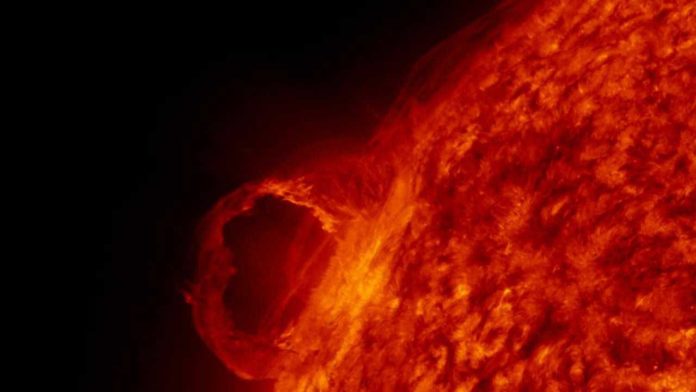Sun releases some potentially hazardous solar particles that are highly charged. Released during storms in its outer atmosphere, these particles can potentially disrupt satellites and electronic infrastructure, as well as pose a radiation risk to astronauts and people in airplanes.
To minimize the danger, scientists seek to understand how these particles’ streams are produced to predict better when they might affect Earth.
Scientists from the UCL and George Mason University, Virginia, USA- recently located the source of hazardous high-energy particles in the Sun. Scientists analyzed the composition of solar energetic particles heading towards Earth.
They found that the particles have the same fingerprint as plasma located low in the Sun’s corona.
Co-author Dr. Stephanie Yardley (UCL Mullard Space Science Laboratory, MSSL) said: “In our study, we have observed for the first time exactly where solar energetic particles come from on the Sun. Our evidence supports theories that these highly charged particles originate from plasma that has been held down low in the Sun’s atmosphere by strong magnetic fields. These energetic particles, once released, are then accelerated by eruptions that travel at a speed of a few thousand kilometers a second.
“Energetic particles can arrive at Earth very quickly, within several minutes to a few hours, with these events lasting for days. Currently, we can only provide forecasts of these events as they are taking place, as it is highly challenging to predict these events before they occur. By understanding the Sun’s processes better, we can improve forecasts so that, when a major solar storm hits, we have time to act to reduce risks.”
Using measurements from NASA’s Wind satellite, scientists analyzed a series of solar energetic particle streams- each lasting at least a day, in January 2014. Later on, they compared this to spectroscopy data from the JAXA-led Hinode spacecraft.
They found that the solar energetic particles measured by the Wind satellite had the same chemical signature as plasma on top of the Sun’s chromosphere. These locations were at the “footpoints” of hot coronal loops. Then a technique was used to measure the strength of the coronal magnetic field at these footpoints.
They found that it was very high, in the region of 245 to 550 Gauss. The measurements also confirm that a strong magnetic field indeed holds down the plasma in the Sun’s atmosphere.
Solar energetic particles are released from the Sun and are accelerated by solar flares (large explosions) or coronal mass ejections – ejections of huge clouds of plasma and magnetic field. About 100 solar energetic particle events occur every 11-year solar cycle, although this number varies from cycle to cycle.
The study supports the idea that some solar energetic particles originate from a different source than the slow solar wind. They are confined in specific conditions in hot coronal loops at the core of the source region.
Lead author Dr. David Brooks (George Mason University and Honorary Associate Professor at UCL MSSL) said: “Our observations provide a tantalizing glimpse into where the material that produces solar energetic particles comes from in a few events from the last solar cycle. We are now starting a new solar cycle, and once it gets going, we will use the same techniques to see if our results are generally true or if these events are somehow unusual.
“We are lucky in that our understanding of the mechanisms behind solar storms and solar energetic particles is likely to advance quickly overcoming years thanks to data that will be gained from two spacecraft – ESA’s Solar Orbiter and the NASA Parker Solar Probe – that are heading closer to the Sun than any spacecraft has been before.”
Journal Reference:
- David H. Brooks et al. The source of the major solar energetic particle events from super active region 11944. DOI: 10.1126/sciadv.abf0068
